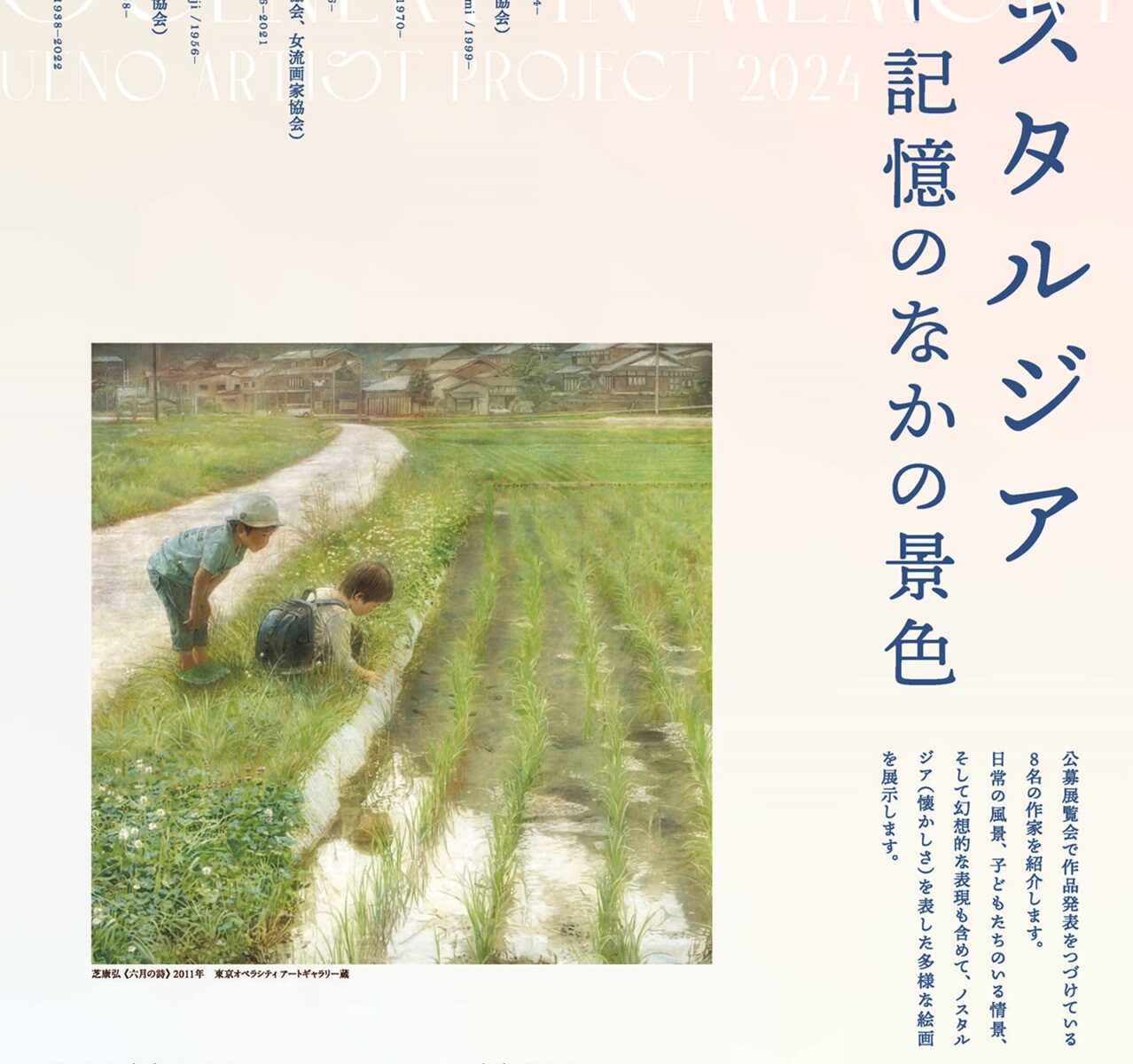Tokyo Metropolitan Art Museum
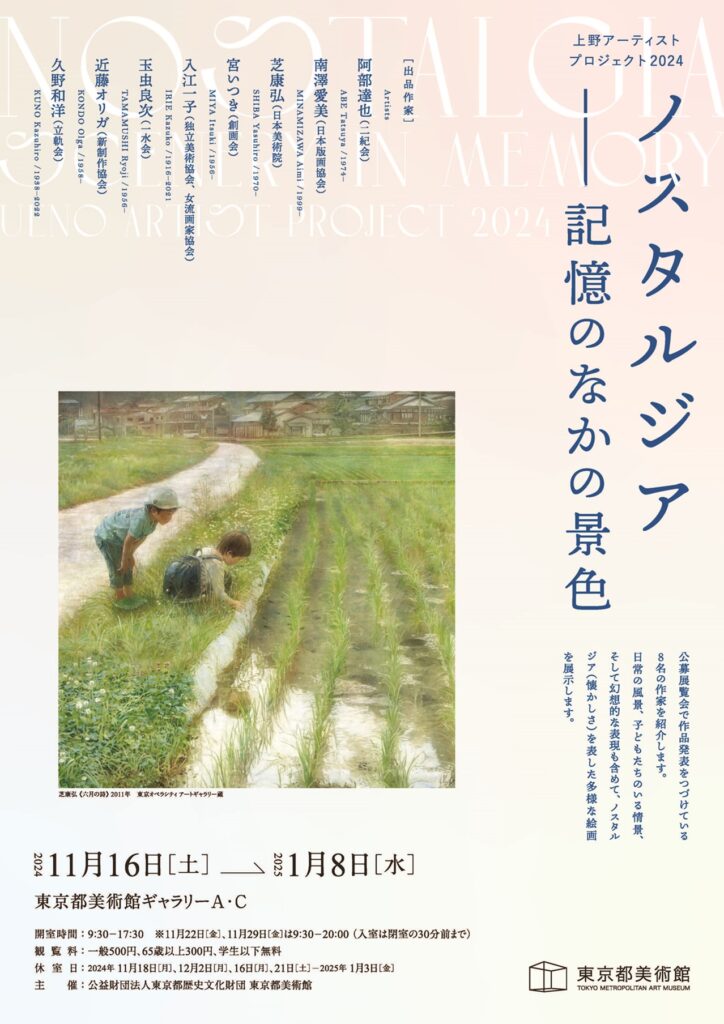
Through eight artists, we will explore the meaning and possibilities of the universal, primal landscape – the complex emotion of nostalgia. “The Genealogy of Nostalgia – From the Taisho Era to the Present, From the Tokyo Metropolitan Collection” will also be held at the same time.
Ueno Artist Project 2024 “Nostalgia – Scenes from Memory”
Ueno Artist Project 2024 Nostalgia ―Scenery in Memory
(Simultaneous event) A Genealogy of Nostalgia: From the Taisho Era to the Present, from the Tokyo Metropolitan Collection”
Date: November 16, 2024 (Saturday) – January 8, 2025 (Wednesday)
The Tokyo Metropolitan Art Museum will hold the Ueno Artist Project 2024 “Nostalgia – Scenes from Memory” from November to January next year.
In this eighth exhibition in the series, we would like to think about familiar landscapes and nostalgia. The word “nostalgia” is originally a compound word of the Greek words “nostos” (going home) and “argos” (pain), and refers to the emotional pain of wanting to return to one’s hometown but never being able to do so. Originally it had a similar meaning to homesickness, but in modern times it refers to the bittersweet and complex emotions felt when memories of the past that can never be returned to are superimposed on the scenery and scenes of the present.
This exhibition introduces eight unique artists who have painted landscapes, scenes with people, and fantasy paintings that strongly evoke this feeling of nostalgia. Abe Tatsuya and Minamizawa Manami lovingly paint everyday cityscapes. Shiba Yasuhiro and Miya Itsuki paint light-filled scenes with children. Irie Kazuko, Tamamushi Ryoji, Kondo Olga, and Kuno Kazuhiro each express their own unique “scenery from memory,” including fantasy. While each of them walks their own different paths, they seem to be searching for a universal, primordial landscape (a primordial landscape deep in the human heart) that seems to transcend time and space. Through their works, this exhibition will explore once again the meaning and possibilities of the complex emotion known as nostalgia.
*The “Ueno Artist Project” is an exhibition series that proactively introduces artists involved in public exhibitions in order to preserve the history of the Tokyo Metropolitan Art Museum, also known as the “home of public exhibitions,” and to promote its future development. Since 2017, it has been held with a different theme each year.
[Highlights of the Exhibition]
(1) Knowing the diversity of nostalgia <br /> This exhibition features “scenes from memory” by eight people of various generations, from those born in the Taisho era to those born in the Heisei era, and who spent their childhoods in different regions and environments. Enjoy the diverse world of nostalgia, expressed through unique expressions of everyday scenes, scenes with children, people from foreign countries, and fantasy cities.
(2) Relax and experience nostalgia in the relaxation space. In the center of Gallery A, which has a 12-meter-high atrium ceiling, there is a rest area the size of an eight-tatami room, surrounded by large paintings by the four artists. In particular, the large 16-meter panorama of 10 pieces from Tamamushi Ryoji’s series Epoch, which he continued to paint over the course of five years, will be on display for the first time in its entirety at this exhibition venue. Nostalgia encourages us to reflect on our lives, and can be an opportunity to reexamine not only a painter’s work but also our own inner selves. Please take your time to appreciate the works here and experience the nostalgia.
(3) Explore the expressions of contemporary artists at the “Nostalgia” exhibition and trace modern history at the “Lineage of Nostalgia” exhibition. The “Lineage of Nostalgia – From the Taisho Period to the Present, from the Tokyo Metropolitan Collection,” held simultaneously in Gallery B, traces the Japanese landscape from the Taisho Period to the present day, and explores once again what kind of “nostalgia” people of each era have found. The exhibition features works in a variety of media, including not only oil paintings, but also woodblock prints, drawings, photographs, books, posters, and photo books. By viewing both exhibitions together, you can experience the various facets of nostalgia.
[Exhibition composition and introduction of participating artists] (in order of exhibition)
Chapter 1 City and Landscape – The painters carefully depict the everyday cityscape that changes with the sunlight, including the subtle changes in light, air, water, and color. Cherishing this everyday life that may no longer exist in the future. It can also be seen as nostalgia for the irreplaceable present from the perspective of the future.
■ABE Tatsuya
Born in Tokyo in 1974. Graduated from the Department of Oil Painting at Musashino Art University in 1999. Began exhibiting at the Niki Exhibition in 2004 and has exhibited every year since. Since around the time of the Great East Japan Earthquake in 2011, he has continued to create landscape paintings that depict wide and deep landscapes such as nearby rivers, oceans, and suburbs as accurately as possible. He is currently a member of the Niki Society.
■ MINAMIZAWA Aimi
Born in Tokyo in 1999. Graduated from Joshibi University of Art and Design, majoring in Western painting, printmaking course in 2022. Winner of the Japan Print Association Award at the 89th Japan Print Association Print Exhibition in 2022. She creates color lithographs featuring the expression of light and ripples, depicting scenes of animals enjoying fishing in rivers, fishing ponds, and public baths.
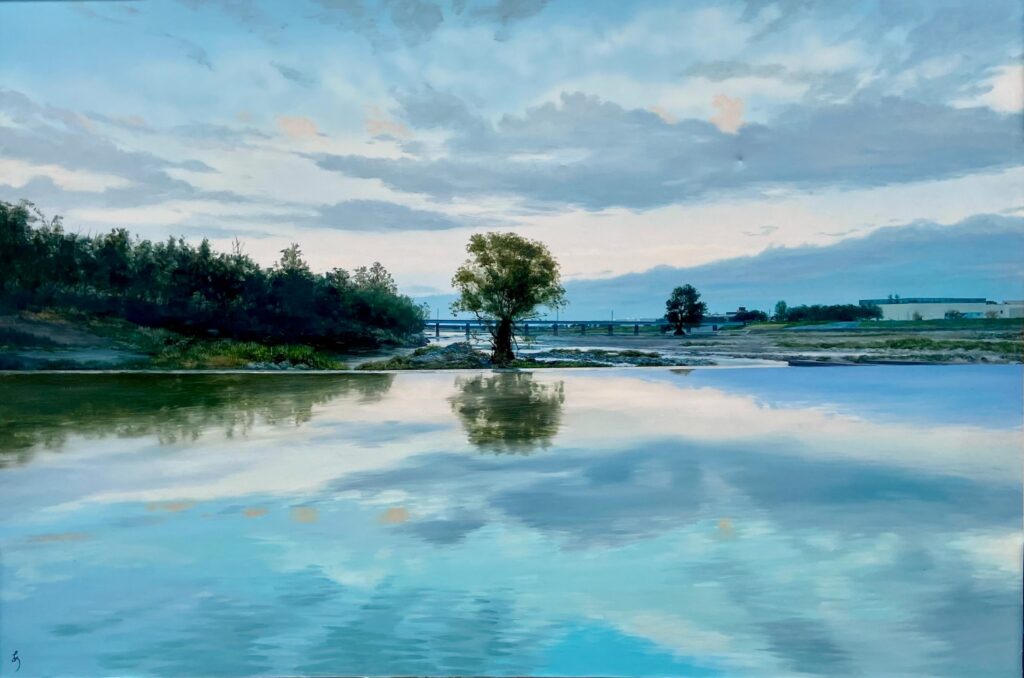
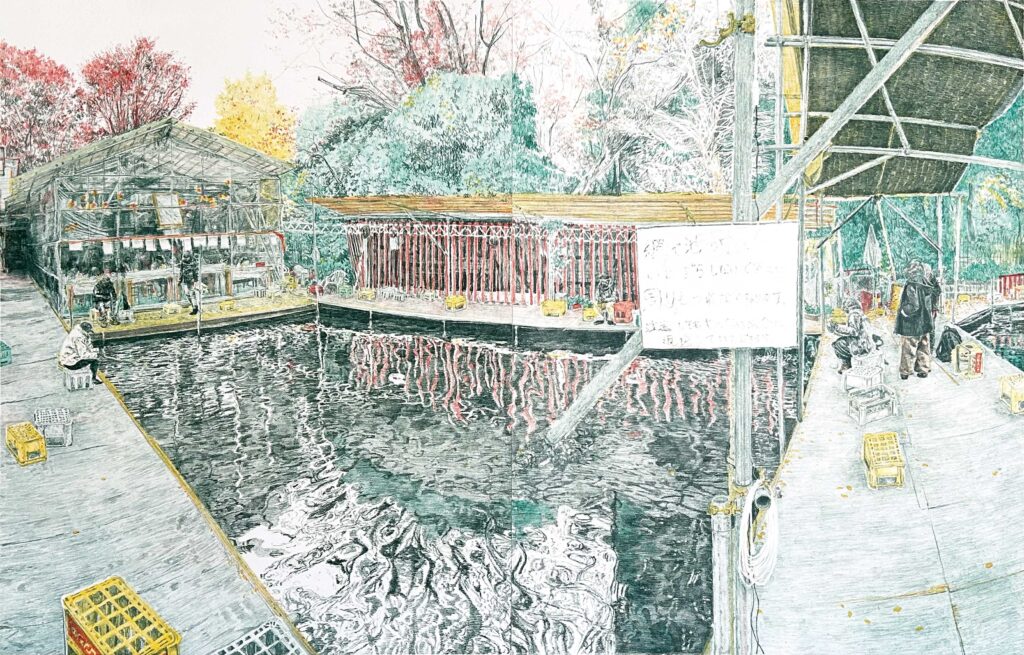
Chapter 2: Children – This section introduces works by two artists who portray their past selves superimposed on children of the present, depicting boys playing and girls relaxing quietly and peacefully.
■ SHIBA Yasuhiro
Born in Tokushima Prefecture in 1970. Graduated from the Japanese Painting Department of Aichi Prefectural University of the Arts in 1994. Has exhibited at Inten exhibitions since his student days. Has held numerous solo exhibitions at Mitsukoshi Nihonbashi and other stores. Part-time lecturer at Aichi Prefectural University of the Arts. Has consistently drawn delicate Japanese paintings of children playing absentmindedly outdoors in the sunlight, using mineral pigments carved into the paint. Currently a scholarship recipient of the Japan Art Academy.
■MIYA Itsuki
Born in Tokyo in 1956. Graduated from the Department of Japanese Painting at Tokyo University of the Arts in 1978. Has been exhibiting at Sogakai since the following year. In 1995, stayed in Ireland and the UK as an overseas dispatched staff member of the Agency for Cultural Affairs. Has been a professor at Tama Art University since 2007 (retires in 2023). Paints scenes of children and women lost in thought in light-filled rooms. Has been highly praised for his intelligent, compositional and decorative paintings that evoke stories and allegories. Currently a member of Sogakai and a professor emeritus at Tama Art University.
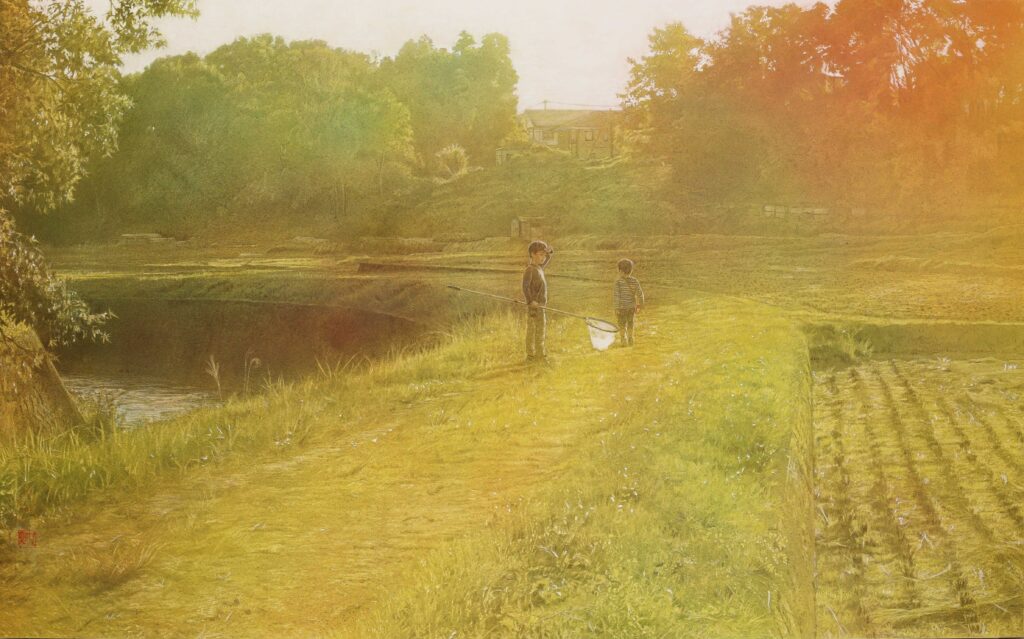
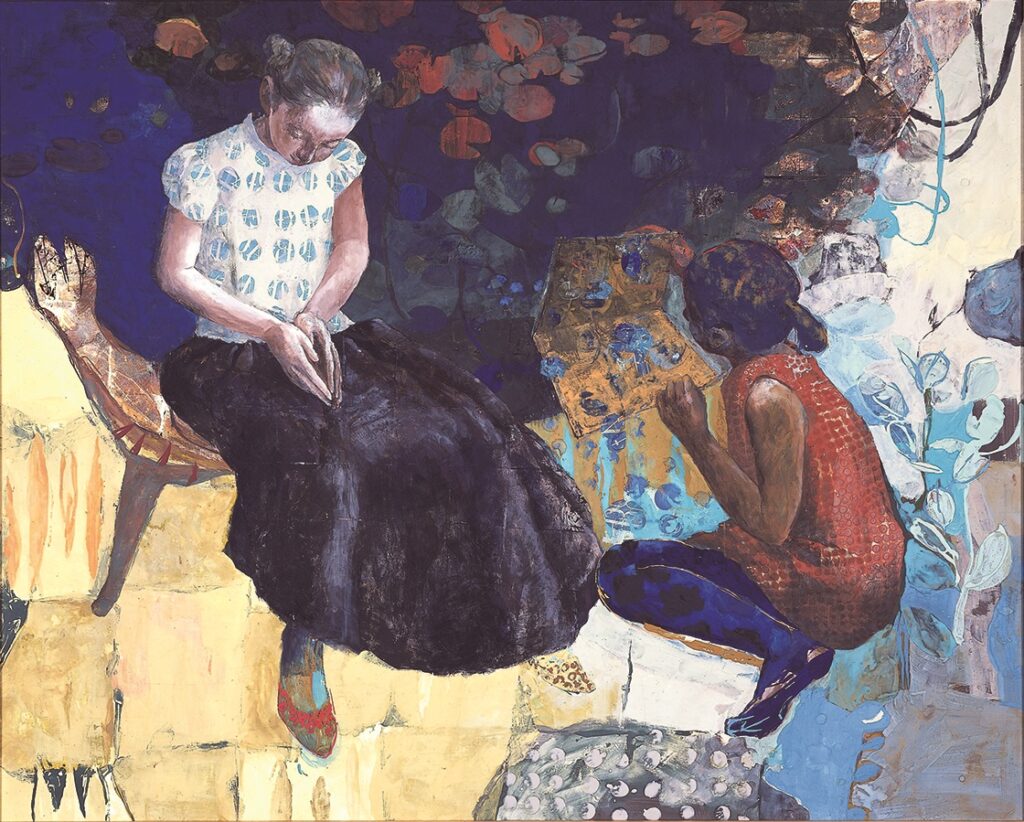
Chapter 3: The Road – A variety of paintings expressing nostalgia, including fantasy, are on display. The strong yearning for a now lost past eventually finds its way to a fantastical landscape that transcends reality.
■IRIE Kazuko
Born in Daegu, Korea, during the Japanese colonial period in 1916. Her father’s family home is in Hagi, Yamaguchi Prefecture. In 1938, she graduated from the Western Painting Department of the Teacher Education Department of Joshibi College of Art and Design (now Joshibi University of Art and Design). She exhibited her work at the Independent Exhibition that same year, and continued to do so thereafter. In 1947, she joined the Association of Women Artists as a founding member. In 1969, she went on a sketching trip along the Silk Road. Since then, she has visited over 30 countries, and painting the landscapes and lives of the people there became her life’s work. She passed away in 2021 (aged 105).
■TAMAMUSHI Ryoji
Born in Saitama Prefecture in 1956. Graduated from the Department of Oil Painting at Musashino Art University in 1979. Exhibited at the Issuikai Exhibition in the same year and has continued to exhibit ever since. Exhibited at the Yasui Award Exhibition (Seibu Museum of Art) in 1983. Received the Excellence Award at the Showakai Award Exhibition in 1997. Became a part-time lecturer at Musashino Art University in 2015. Reconstructing nostalgic scenes from the Showa era, he has established unique oil paintings that overlap with a sense of discomfort with modern society. He is currently a member of the Issuikai Executive Committee.
■KONDO Olga
Born in Belarus in 1958. Graduated from the Belarus State University of Fine Arts in 1983. Came to Japan in 2007 and has been living in Japan since then. Continued to exhibit at the Shinseisaku Association and became a member in 2017. Won the Excellence Award at the 1st Sompo Japan Art Award Exhibition (FACE2013) in 2013. Creates paintings that bring to life familiar family, nature, flowers and fruit from his homeland in deep spaces enveloped in milky white gradations and soft light. Currently a member of the Shinseisaku Association.
■ KUNO Kazuhiro
Born in Aichi Prefecture in 1938. Graduated from the Western Painting Department of Musashino Art School in 1963. Studied in Europe and studied abroad from 1973-76 on a scholarship from the same art school. Became a member of the Rikki-kai in 1982. Studied in Italy as an overseas trainee sent by the Agency for Cultural Affairs from 1991-92. Became a professor at Musashino Art University in 2002. A researcher of European classical painting, he was highly acclaimed for his Earthscapes series, which feature deep space backed by profound matière. He will pass away in 2022 (aged 83).
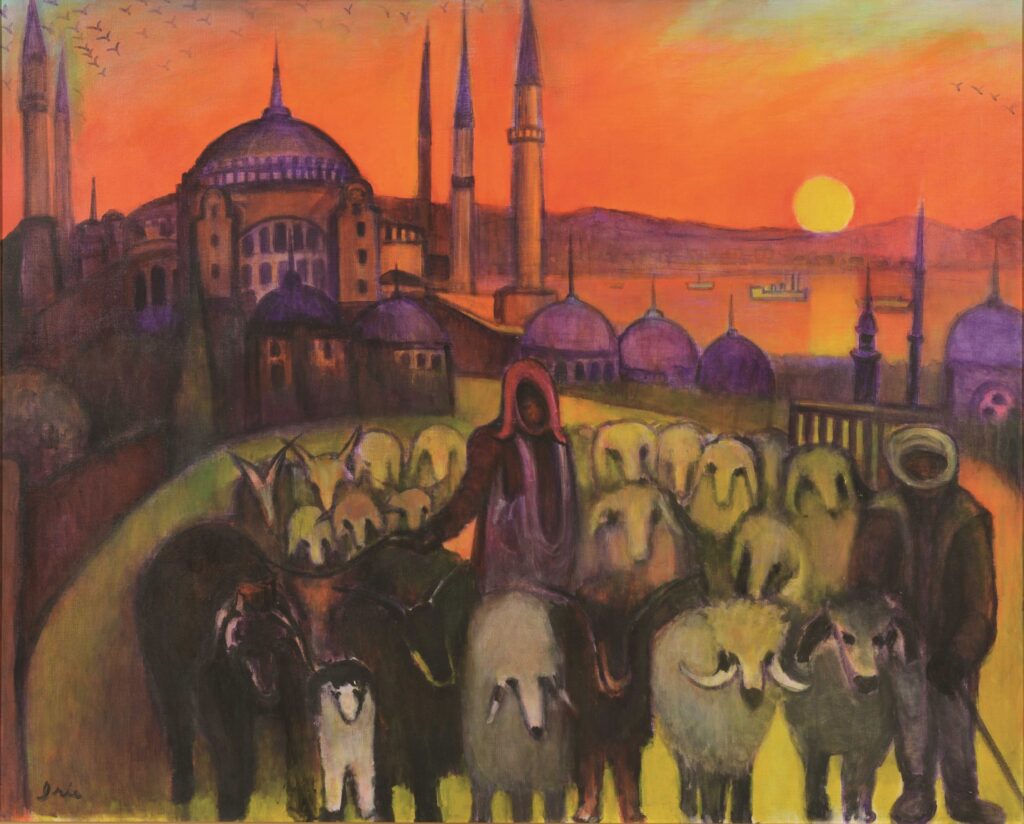
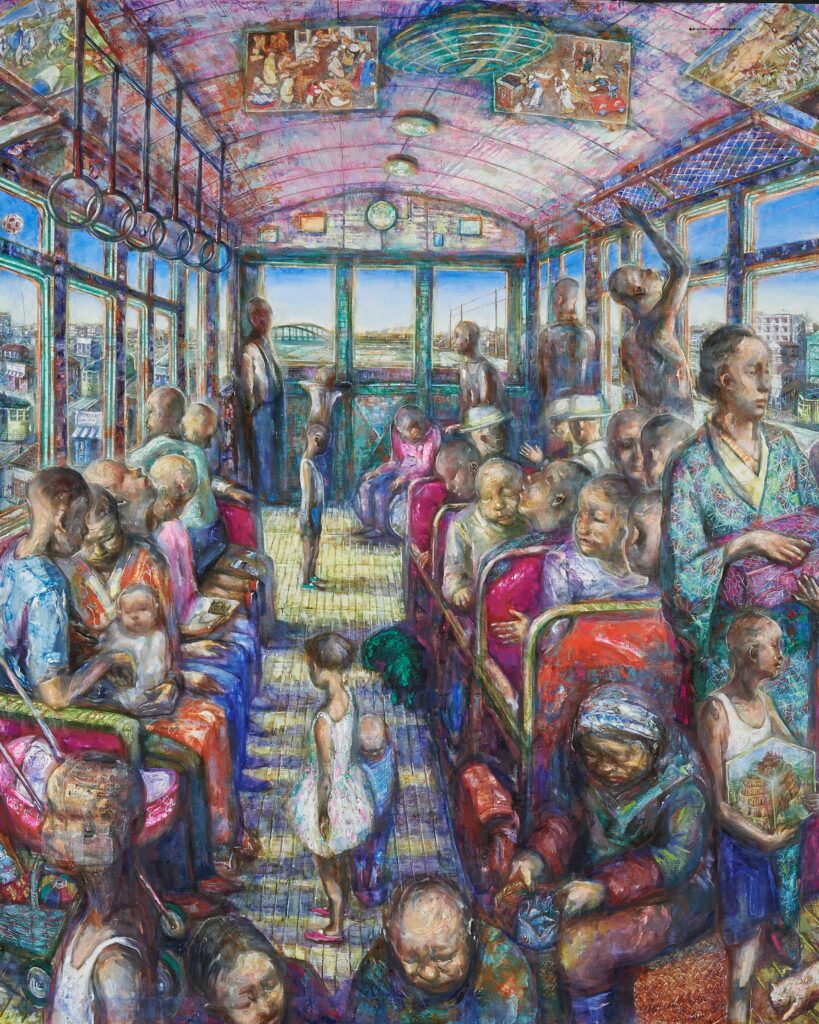
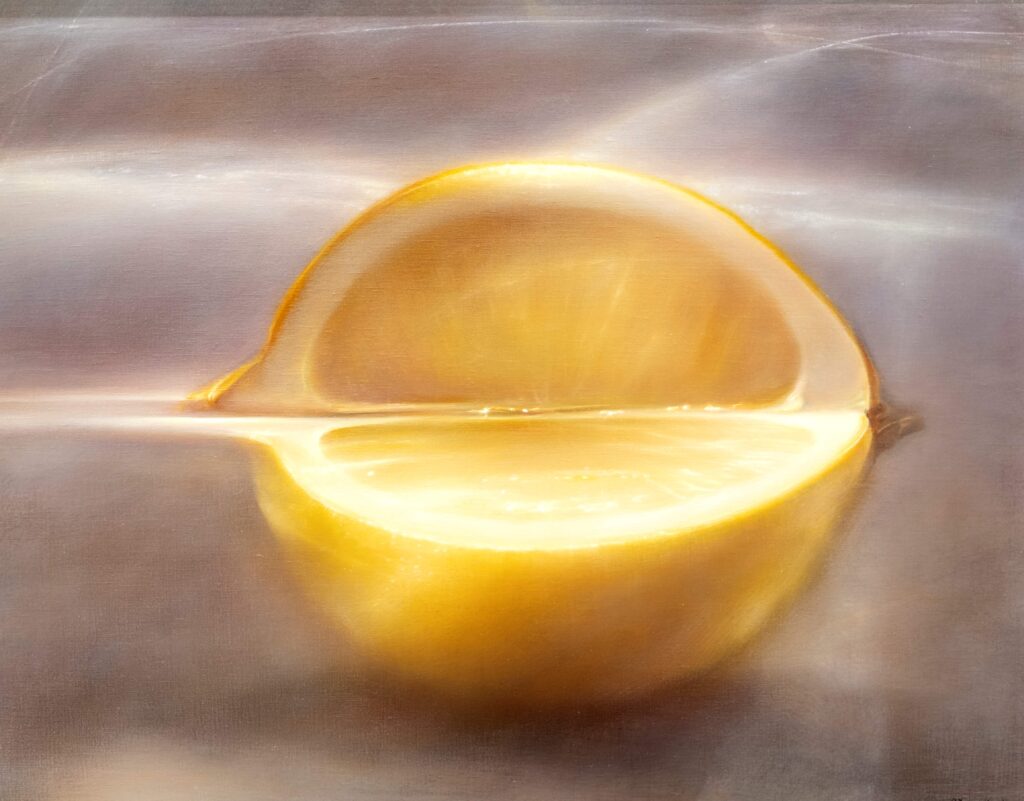

◆Event Overview
■Exhibition name: Ueno Artist Project 2024 “Nostalgia – Scenes in Memory”
Ueno Artist Project 2024: Nostalgia ―Scenery in Memory
■Period: November 16, 2024 (Saturday) – January 8, 2025 (Wednesday)
■ Venue: Tokyo Metropolitan Art Museum, Galleries A and C
■Closed days: November 18th (Monday), December 2nd (Monday), 16th (Monday), 21st (Saturday), 2024 – January 3rd (Friday), January 6th (Monday), 2025
■Opening hours: 9:30-17:30 (entry allowed until 30 minutes before closing)
■ Nighttime opening hours: Friday, November 22nd and Friday, November 29th: 9:30am-8:00pm (entry until 30 minutes before closing)
■ Admission fee: 500 yen for adults, 300 yen for those 65 and over, free for students and younger. * Free for those who have a disability certificate, love certificate, rehabilitation certificate, mental health and welfare certificate, or atomic bomb victim health certificate, and their attendant (up to one person) * Please show proof of identity. * Free for elementary, junior high, and high school students in Tokyo and those of similar status and their accompanying teachers who are viewing as part of a school education activity (application required in advance).
*Free admission upon showing a ticket for the special exhibition “Tanaka Isson Exhibition” (until December 1st) ■Organizers: Tokyo Metropolitan Foundation for History and Culture, Tokyo Metropolitan Art Museum ■Exhibition website https://www.tobikan.jp/exhibition/2024_uenoartistproject.html
■Contact information: Tokyo Metropolitan Art Museum 03-3823-6921
[Concurrent Event] A Genealogy of Nostalgia: From the Taisho Era to the Present, from the Tokyo Metropolitan Collection
Tokyo Metropolitan Collection Exhibition:
Genealogy of Nostalgia ― From the Taisho Era to the Present
From the collection of the Tokyo Metropolitan Government, we will be showcasing paintings of scenes from the past as well as photographs of modern city suburbs. By tracing the landscapes of Japan from the Taisho period to the present day, we hope to reconsider what it is about the “nostalgia” that people have found in them.
There is the “nostalgia” for the prewar Taisho and Showa eras that disappeared amid modernization, as captured by Kawase Hasui and Domon Ken, the “nostalgia” for American culture that flooded into Japan in large numbers after the war, and the “nostalgia” for the city and suburban streets that have been homogenizing and transforming repeatedly against the backdrop of rapid economic growth. Although each of these “nostalgia” comes from a completely different era and aspect, it may be a common emotion that can sprout in anyone’s heart. We hope that this exhibition, which considers the diversity and immutability of nostalgia, will serve as an opportunity to reflect on ourselves as we live in this turbulent modern and contemporary society.

Main exhibits


[Event Summary]
■Exhibition title: Genealogy of Nostalgia – From the Taisho Era to the Present, from the Tokyo Metropolitan Collection ■Dates: Saturday, November 16, 2024 – Wednesday, January 8, 2025
■ Venue: Tokyo Metropolitan Art Museum, Gallery B
■Closed: Monday 18th November, Monday 2nd December, Monday 16th December, Saturday 21st November, 2024 – Friday 3rd January, Monday 6th January, 2025 *Some exhibits will be changed out (first period: until Thursday 5th December).
■Opening hours: 9:30-17:30 (entry allowed until 30 minutes before closing)
■ Nighttime opening hours: Friday, November 22nd and Friday, November 29th: 9:30-20:00 (entry until 30 minutes before closing)
■Admission fee: Free ■Organizers: Tokyo Metropolitan Government, Tokyo Metropolitan Foundation for History and Culture, Tokyo Metropolitan Art Museum ■In cooperation with: Tokyo Metropolitan Foundation for History and Culture, Edo-Tokyo Museum, Tokyo Photographic Art Museum, Museum of Contemporary Art Tokyo
◆ Related businesses
■Talks and lectures Venue: Tokyo Metropolitan Art Museum Auditorium Capacity: 200 people per session *Participation is free, first come first served [Sign language interpretation available]
1. Artist Talk “Artists Talk about Nostalgia 1”
November 23rd (Saturday, holiday) 14:00-15:30
Tatsuya Abe and Ryoji Tamamushi
2. Artist Talk: “Artists Talk about Nostalgia 2”
December 1st (Sun) 14:00-15:30
Yasuhiro Shiba, Itsuki Miya
3. Artist Talk: “Artists Talk about Nostalgia 3”
Saturday, December 7th 14:00-15:30
Manami Minamizawa, Olga Kondo
4. Lecture by the curator in charge: “Nostalgia and Artists”
Saturday, December 14th 14:00-15:30
*Content is subject to change.
*For more details and the latest information, please see here → https://www.tobikan.jp/exhibition/2024_uenoartistproject.html
=================
■Dance Well [Advance registration required]
“Dance Well” is a dance program that anyone can participate in, from children to adults, mainly for people living with Parkinson’s disease. Why not view the exhibition and express the sensations and images you have gained from it using your whole body?
Venue: Tokyo Metropolitan Art Museum Gallery, Studio Date and time:
1st Sunday, December 8, 2024 14:00-15:30
Instructor: Naoyuki Sakai (dancer, filmmaker, DanceWell instructor)
2nd session: January 4, 2025 (Sat) 14:00-15:30
Instructor: Sachiko Higashino (choreographer, director, dancer, representative of ANTIBODIES Collective, instructor at DanceWell)
Participation fee: Free (However, a same-day ticket for the “Nostalgia” exhibition is required)
Capacity: 20 people per session. Advance registration required. *Applications will be accepted from Friday, November 1st via the application form on our website. *Applications will be closed once capacity is reached on a first-come, first-served basis. *If you require a sign language interpreter, please apply one week prior to the event by writing “Sign language interpreter requested” in the comments section of the application form.
=================
Lecturer Introduction
Sakai Naoyuki <br />Dancer, filmmaker, dancewell instructor. Graduated from Tokyo University of the Arts Graduate School. In addition to appearing in numerous stage productions both in Japan and abroad, he also appears in and provides choreography for music videos and musicals. Based in Kasukabe City, he organizes events and distributes videos with the aim of building towns through art. In 2023, he spent a year in Italy researching dancewell and its urban development as part of the Agency for Cultural Affairs’ “Budding Artists Overseas Training Scheme” program.
Higashino Sachiko
He is the founder of the performance art collective “ANTIBODIES Collective”, which is made up of choreographers, directors, dancers, and artists from various genres. He has won numerous awards, including the Toyota Award and Yokohama Dance Collection. He is the artistic director of All Japan Dance Track. In 2016, he was a lecturer at Dance Well in Bassano del Grappa, Italy. In the summer of 2019, he completed the Dance Well Teachers Course.
■Tokyo Metropolitan Art Museum <br />Exhibition websitehttps ://www.tobikan.jp/exhibition/2024_uenoartistproject.html
Contact: 03-3823-6921
[Tokyo Metropolitan Foundation for History and Culture] Press release
See other exhibition information


